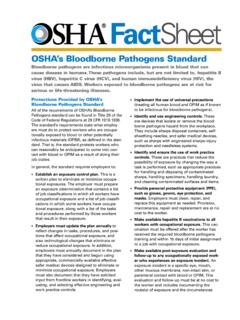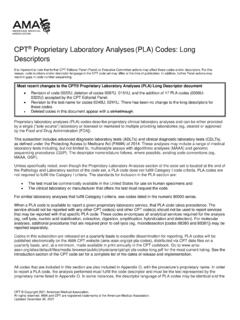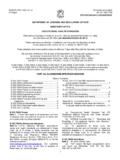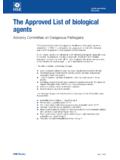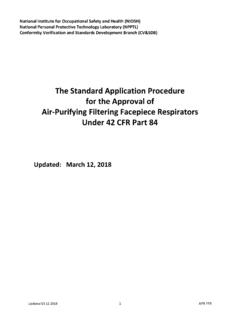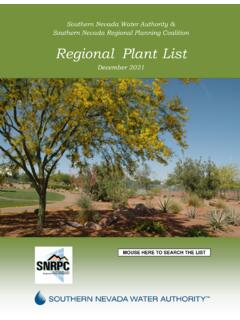Transcription of NHSN LCBI Checklist - Centers for Disease Control and ...
1 January 2022 2022 NHSN Laboratory Confirmed Bloodstream Infection (LCBI) Checklist Laboratory Confirmed Bloodstream Infection (LCBI) Summary Criterion Criterion Met Date of Event (DOE) LCBI 1 LCBI 2 LCBI 3 MBI-LCBI 1 MBI-LCBI 2 MBI-LCBI 3 Please refer to Chapter 4 Bloodstream Infection (BSI) Event of the Patient Safety Manual for additional information. January 2022 Documentation Review Checklist Laboratory Confirmed Bloodstream Infection (LCBI) LCBI 1 If LCBI 1 criteria is met, consider MBI-LCBI 1 Element Element Met Date Patient of any age has A recognized bacterial or fungal pathogen not included on the NHSN common commensal list: 1. Identified from one or more blood specimens obtained by a culture OR 2.
2 Identified to the genus or species level by non-culture based microbiologic testing (NCT)* methods (for example, T2 Magnetic Resonance [T2MR] or Karius Test). Note: If blood is collected for culture within 2 days before or 1 day after the NCT, disregard the result of the NCT and use only the result of the CULTURE to make an LCBI surveillance determination. If no blood is collected for culture within this time period, use the result of the NCT for LCBI surveillance determination. *For the purposes of meeting LCBI-1, NCT is defined as a methodology that identifies an organism directly from a blood specimen without inoculation of the blood specimen to any culture media. For instance, NCT does not include identification by PCR of an organism grown in a blood culture bottle or any other culture media.
3 AND Organism(s) identified in blood is not related to an infection at another site (See Chapter 4 Appendix B: Secondary BSI Guide). Notes: 1. If a patient meets both LCBI 1 and LCBI 2 criteria, report LCBI 1 with the recognized pathogen entered as pathogen #1 and the common commensal as pathogen #2. 2. No additional elements (in other words, no sign or symptom such as fever) are needed to meet LCBI 1 criteria; therefore, the LCBI 1 DOE will always be the collection date of the first positive blood specimen used to set the BSI IWP. Comments/Notes: January 2022 Documentation Review Checklist Laboratory Confirmed Bloodstream Infection (LCBI) LCBI 2 If LCBI 2 criteria is met, consider MBI-LCBI 2 Element Element Met Date Patient of any age has at least one of the following signs or symptoms: Fever (>38 C) Chills Hypotension AND Organism(s) identified in blood is not related to an infection at another site (See Chapter 4 Appendix B: Secondary BSI Guide).
4 AND The same NHSN common commensal is identified by a culture from two or more blood specimens collected on separate occasions (see Blood Specimen Collection). Common Commensal organisms include, but are not limited to, diphtheroids (Corynebacterium spp. not C. diphtheria), Bacillus spp. (not B. anthracis), Propionibacterium spp., coagulase-negative staphylococci (including S. epidermidis), viridans group streptococci, Aerococcus spp. Micrococcus spp. and Rhodococcus spp. For a full list of common commensals, see the Common Commensals tab of the NHSN Organism List. Notes: 1. Criterion elements must occur within the 7-day IWP (as defined in Chapter 2 Identifying HAIs for NHSN Surveillance) which includes the collection date of the positive blood specimen, the 3 calendar days before and the 3 calendar days after.
5 2. The two matching common commensal specimens represent a single element for use in meeting LCBI 2 criteria and the collection date of the first specimen is used to determine the BSI IWP. 3. At least one element (specifically, a sign or symptom of fever, chills, or hypotension) is required to meet LCBI 2 criteria; the LCBI 2 DOE will always be the date the first element occurs for the first time during the BSI IWP, whether that be a sign or symptom or the positive blood specimen. Comments/Notes: January 2022 Documentation Review Checklist Laboratory Confirmed Bloodstream Infection (LCBI) LCBI 3 If LCBI 3 criteria is met, consider MBI-LCBI 3 Element Element Met Date Patient 1 year of age has at least one of the following signs or symptoms: Fever (>38 C) Hypothermia (< C) Apnea Bradycardia AND Organism(s) identified in blood is not related to an infection at another site (See Chapter 4 Appendix B: Secondary BSI Guide).
6 AND The same NHSN common commensal is identified by a culture from two or more blood specimens collected on separate occasions (see Blood Specimen Collection). Common Commensal organisms include, but are not limited to, diphtheroids (Corynebacterium spp. not C. diphtheria), Bacillus spp. (not B. anthracis), Propionibacterium spp., coagulase-negative staphylococci (including S. epidermidis), viridans group streptococci, Aerococcus spp. Micrococcus spp. and Rhodococcus spp. For a full list of common commensals, see the Common Commensal tab of the NHSN Organism List. Notes: 1. Criterion elements must occur within the 7-day IWP (as defined in Chapter 2 Identifying HAIs for NHSN Surveillance) which includes the collection date of the positive blood specimen, the 3 calendar days before and the 3 calendar days after.
7 2. The two matching common commensal specimens represent a single element for use in meeting LCBI 3 criteria and the collection date of the first specimen is used to determine the BSI IWP. 3. At least one element (specifically, a sign or symptom of fever, hypothermia, apnea, or bradycardia) is required to meet LCBI 3 criteria; the LCBI 3 DOE will always be the date the first element occurs for the first time during the BSI IWP whether that be a sign or symptom or the positive blood specimen. Comments/Notes: January 2022 Documentation Review Checklist Mucosal Barrier Injury Laboratory-Confirmed Bloodstream Infection (MBI-LCBI) Must meet one of the following MBI-LCBI criteria MBI-LCBI 1 Element Element Met Date Patient of any age fully meets LCBI 1 criteria with at least one blood specimen: 1.
8 Identified from one or more blood specimens obtained by a culture OR 2. Identified to the genus or species level by non-culture based microbiologic testing (NCT) methods (for example, T2 Magnetic Resonance [T2MR] or Karius Test). Note: If blood is collected for culture within 2 days before or 1 day after the NCT, disregard the result of the NCT and use only the result of the CULTURE to make an LCBI surveillance determination. If no blood is collected for culture within this time period, use the result of the NCT for LCBI surveillance determination. AND ONLY intestinal organisms from the NHSN MBI organism list are identified* AND Patient meets at least one of the following: 1.
9 Is an allogeneic hematopoietic stem cell transplant recipient within the past year with one of the following documented during same hospitalization as positive blood specimen: a. Grade III or IV gastrointestinal graft versus host Disease [GI GVHD] OR b. 1-liter diarrhea in a 24-hour period (or 20 mL/kg in a 24-hour period for patients <18 years of age) with onset on or within the 7 calendar days before the date the positive blood specimen was collected. OR 2. Is neutropenic, defined as at least two separate days with ANC and/or WBC values <500 cells/mm3 collected within a 7-day time period which includes the collection date of the positive blood specimen, the 3 calendar days before and the 3 calendar days after (See Chapter 4 Table 5).
10 January 2022 MBI-LCBI 2 Patient of any age fully meets LCBI 2 criteria with at least two matching blood specimens identified by culture AND ONLY Viridans Group Streptococcus and/or Rothia spp. alone but no other organisms are identified AND Patient meets at least one of the following: 1. Is an allogeneic hematopoietic stem cell transplant recipient within the past year with one of the following documented during same hospitalization as positive blood specimen: a. Grade III or IV gastrointestinal graft versus host Disease [GI GVHD] OR b. 1-liter diarrhea in a 24-hour period (or 20 mL/kg in a 24-hour period for patients <18 years of age) with onset on or within the 7 calendar days before the date the positive blood specimen was collected.










